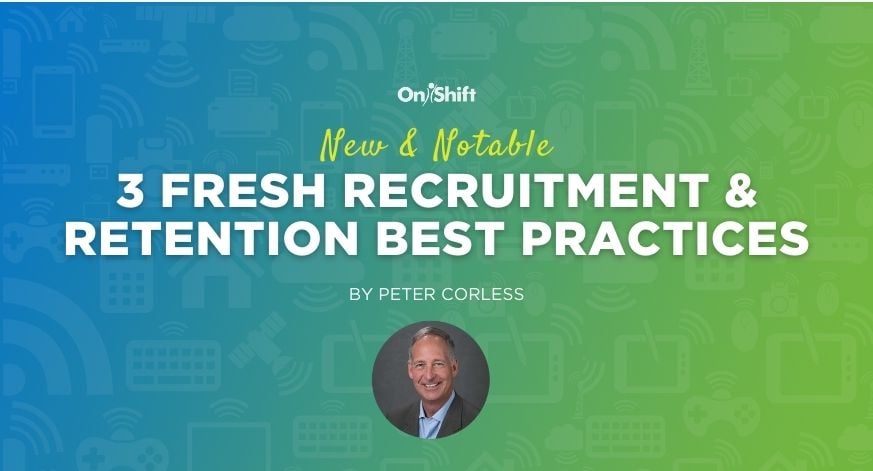May 26, 2021 | Peter Corless
May 26, 2021 | Peter Corless
 There’s no shortage of best practice sharing across this profession, which is a true testament to both the resourceful nature of those working in senior care and the sense of community that we’ve built. To that end, a few new workforce-related strategies have caught my attention and I’d like to them pass along.
There’s no shortage of best practice sharing across this profession, which is a true testament to both the resourceful nature of those working in senior care and the sense of community that we’ve built. To that end, a few new workforce-related strategies have caught my attention and I’d like to them pass along.
1. Community Virtual Learning Classrooms As A Recruiting Tool
A member of the AHCA/NCAL Workforce Committee recently shared how a community is putting unoccupied resident rooms to good use by turning them into virtual classrooms for employees’ children. My colleague said that while students are responsible for their own learning, the community will provide supervision to ensure safety.
This community plans to use this offering as part of their effort to attract first shift workers/parents that would otherwise stay home with their children.
2. A Mission-Based, Employee-First Approach, Even During Tough Times
Skilled Nursing News recently did a feature on Goodwin House Inc., which operates two Northern Virginia communities – Goodwin House Alexandria; and Goodwin House Bailey’s Crossroads. The organization has many of the same pandemic challenges as its competitors but successfully retained its 870-person full-time workforce, consisting of RNs, LPNs, CNAs, environmental services, maintenance, dining services, administrative, life enrichment, marketing, finance, sales, social work, procurement and IT teams.
Fran Casey, the company’s Chief People Officer, says it goes back to the company's mission to “support, honor and uplift the lives of older adults and the people who care for them through a faith-based, nonprofit organization affiliated with the Episcopal Church.” The “and” in there is critical and something that sets them apart from the competition.
“When presented with solutions for facing challenges brought on by Covid-19, our competitors say, “No we can’t.” We focus on getting to “yes we can.” If we have to, we look for savings in other places. We never want to sacrifice the needs of our employees,” Casey explains.
Some of their virus mitigation tactics to keep residents and staff safe include hiring a dedicated employee to test and track cases and bringing on extra housekeeping and care staff to increase infection control and ease the burden of their current RNs, LPNs, and CNAs. Most importantly, she says, this approach ensured residents received the best possible care when they needed it most.
3. Rethinking The Value Of Internship Programs
One organization is seeing tremendous value in the internship program they have in place. In a recent McKnight’s Senior Living article, Michelle Sayre, CTRS, CDP, who is the community life director at the Fountains at Lake Pointe Wood, says these programs don’t just benefit the students that participate (via exposure to the industry, valuable learning experience, etc.), but can also be very valuable to the host organization.
“Over the years, I’ve learned just as much from my interns as they have learned from me. I’ve witnessed residents gravitate toward interns and connect with them in new ways,” she explains. “And I’ve watched as interns have grown, both personally and professionally, during their time at the community to the benefit of everyone involved."
Sayre recommends taking a few steps to get the most out of your internship program, based on the recent success they’ve had with their partnership with Florida International University. First, make sure you understand the requirements of the program and ensure your team has the time and resources to fulfill them. This will also help you create a custom curriculum for smoother onboarding.
Next, be sure to involve the intern in everything related to the department they work in. Give them the chance to shadow multiple roles in the department, while keeping in mind, “The commitment always should be to educate the intern while simultaneously improving the experience of residents,” Sayre says.
Finally, take the opportunity to learn from the intern. “Listen to his or her ideas, ask for input, and look for ways the intern can help you improve current protocols,” she says.
She says the biggest benefit they’ve realized from the program is the fresh knowledge and industry practices these interns bring to the table. “For some associates, it has been more than 20 years since they were in school, and the curriculum no longer is fresh in their mind. Our intern has taught us new terminology and offered a renewed perspective,” Sayre explains.
You can read more about their program’s success here.
Let’s Keep The Conversation Going
Have a new and noteworthy workforce practice you’d like to share? I’m all ears! Send me an email.
Subscribe to the OnShift Blog
Recent Posts
Categories
About Peter Corless
Peter Corless is Executive Vice President of Enterprise Development for OnShift. Peter is a recognized HR leader in post-acute care and is well-known for his achievements at some of the country’s largest post-acute care organizations, including Kindred Healthcare and Genesis HealthCare. As an experienced, chief administrative and human resources officer within these organizations, he developed strategies that reduced turnover, improved recruiting and hiring strategies, and reduced labor costs.
See for yourself why thousands of providers rely on OnShift’s innovative software for recruitment, hiring, workforce management, pay and engagement. Request your personalized demo today.
